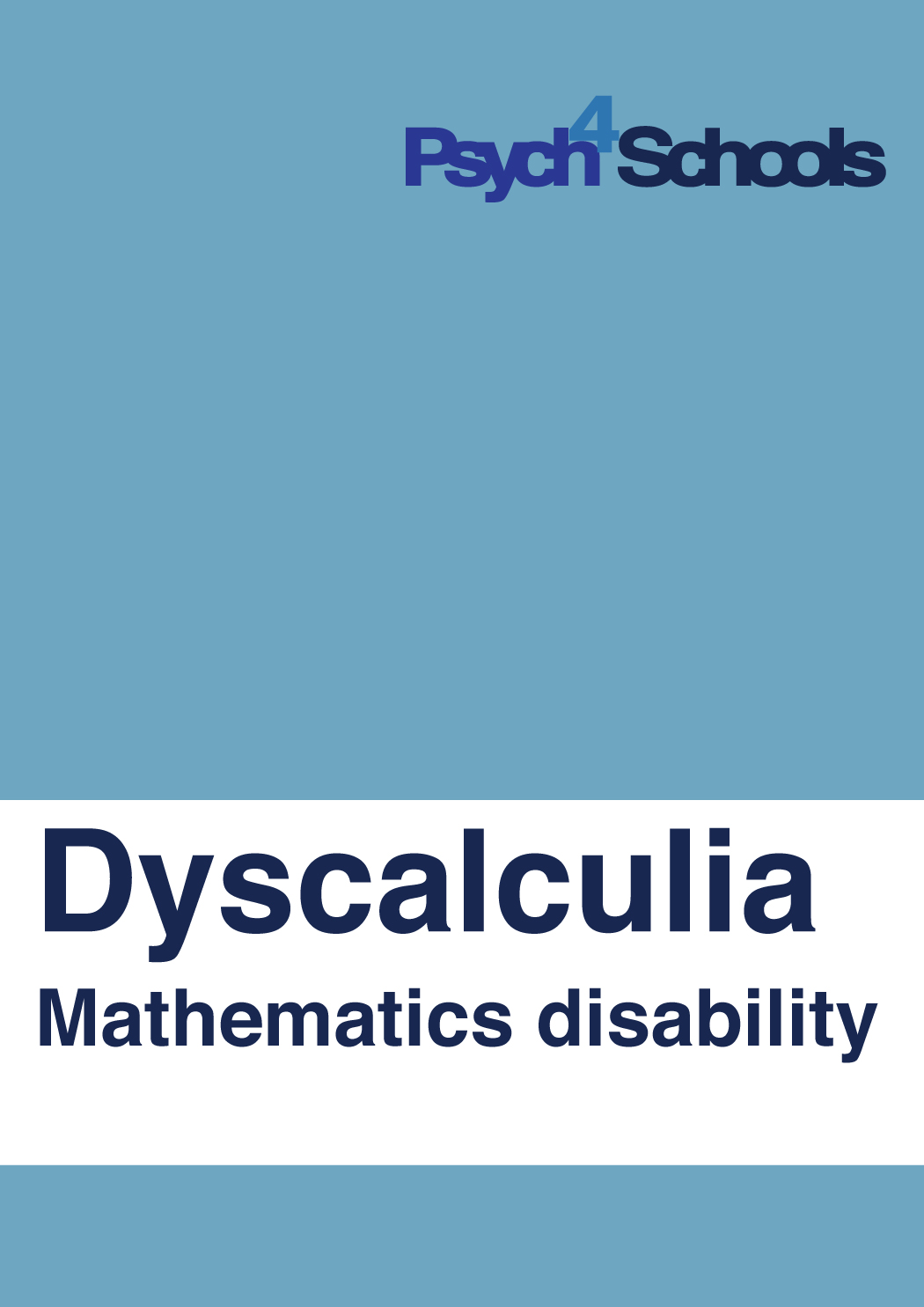Dyscalculia (mathematics disability)
The following is an excerpt from the ebooklet Working with children diagnosed with Dyscalculia (mathematics disability) by Murray Evely and Zoe Ganim.
Introduction
Children with dyscalculia have a poor sense of number. They experience significant difficulties understanding the size or quantity of a number and thus the relationship of numbers to one another[1] American Psychiatric Association. (2013). Diagnostic and statistical manual of mental disorders (5th ed.). Arlington, VA: American Psychiatric … Continue reading . Approximately 3 to 6 per cent of children suffer from dyscalculia[2] utterworth, B. (2010). “Foundational numerical capacities and the origins of dyscalculia”. Trends in Cognitive Sciences, 14(12), … Continue reading. With between 5 to 8 per cent of school-age children having significant problems with mathematics [3] Garnett, K. (1998). “Math learning disabilities.” Learning Disabilities Journal. L.D Online. Retrieved February 11, 2008, … Continue reading, it is apparent that dyscalculia is a major component of these difficulties.
The term ‘dyscalculia’ is used interchangeably with ‘mathematics disability’ and the DSM-5 (Diagnostic and Statistical Manual of Mental Disorders, Fifth Edition) clinical classification, ‘Specific learning disorder with impairment in mathematics’. Children with dyscalculia lack an intuitive grasp for number; as a result they have significant difficulties mastering number sense, number facts, calculation and mathematical reasoning.
Although maths difficulties are as common as reading difficulties they often go undetected or undiagnosed by teachers and psychologists. This may be because dyscalculia is still a relatively unknown disorder, however research and awareness is now growing.
Alternatively children may go undetected due to some adults believing that the child with maths difficulties just doesn’t have the aptitude or is not sufficiently ‘brainy’ [4] Williams, A, (2013). “A teacher’s perspective of dyscalculia: Who counts? An interdisciplinary overview.” Australian Journal of Learning … Continue reading for mathematics.
Deficits associated with dyscalculia can significantly limit secondary and tertiary studies and employment opportunities, and impact on a person’s everyday living and independence affecting financially literacy, including ability to shop and budget.
As dyscalculia persists into adulthood [5] Shalev, R. S., Auberbach, J., Manor, O., Gross-Tsur, V. (2000). “Developmental dyscalculia: prevalence and prognosis.” European journal of … Continue reading, early targeted teacher intervention and remediation is critical.
Characteristics of children with dyscalculia
Children with dyscalculia have significant difficulties in understanding the quantity or magnitude of numbers. Their poor ‘number sense’ leads them to have significant difficulties in the following [6] Butterworth, B. (2002 & 2005). Dyslexia and dyscalculia: a review and programme of research. . University College London: Institute of … Continue reading.
- Giving numbers meaning. Understanding size or quantity of number is poor.
- Knowing simple comparisons, for example ‘Which is bigger, 4 or 8?’
- Having ‘sight recognition’ for quantity, so a quantity can be ‘seen’ without counting. For example, recognising a small number of items such as five objects by sight without counting.
- Processing written numbers automatically. For example, when most children see the numeral ‘3’ they automatically think a small quantity, however for children with dyscalculia the link between written number and quantity is not automatic. Processing quantity is slow and requires effort.
- Arithmetic and mental computation. Children with dyscalculia are slow with both of these skills, often using immature strategies.
In the classroom
Children with dyscalculia display significant mathematical delays when compared with peers or to benchmarks or standards. They generally have a dislike of, and anxiety about, maths and difficulties with the following:
- Naming numbers quickly and accurately.
- Learning to count forwards and backwards without making errors.
- Understanding basic counting principles. For example, the principle that as long as one-to-one correspondence is maintained, it doesn’t matter in which order objects are counted.
- Use of efficient strategies for simple addition and subtraction. For example, rather than using effective rules such as ‘make to 10’ for a known sum to foster automatic recall when solving simple computations, they use slow, immature or incorrect strategies like finger counting.
- Confusing mathematical signs +, –, x, ÷ and =.
- Memorising simple arithmetic facts, such as simple addition, subtraction and multiplication facts. For example, 8 + 2 = 10 or 8 + 3 = 11 may not be automatically known.
- Solving basic maths problems.
- Estimating size, number and distance, telling the time using analogue clocks, and conceptualising concepts such as ‘greater than’ or ‘smaller than’ or ‘the difference between’.
- Understanding and remembering mathematical rules, concepts and formulae.
- Transferring knowledge from one maths area to another or using existing maths knowledge to solve a maths problem.
- Understanding and consistently using place value. For example, not aligning numbers correctly on the page to calculate simple equations, not knowing what the 2 means in 27.
- Improving maths performance and attainment. They show little or no improvement following repeated instruction or one-to-one assistance.
The following problems are often associated with dyscalculia:
- Difficulties associated with drawing and understanding maps, spatial designs and 3D objects.
- Understanding of time, direction and location of objects.
- Tendency to lose belongings and present as disorganised.
- Poor with coordination, handwriting and setting out of written work.
- Difficulty concentrating and attending.
- Diagnosed with dyslexia. Research indicates anywhere from 16 to 64 per cent [7] of children with dyscalculia are diagnosed with dyslexia. Some researchers believe dyscalculia and dyslexia co-occur at roughly 50 per cent [8].
- Working memory issues – problems holding information in the mind while performing an operation with it. Children may be able to perform some mathematics operations one day but not the next.
- Issues using money and paying for items to purchase.
- Display of challenging behaviours during maths lessons.
- Low self-efficacy. Poor self-belief, worry and poor coping strategies can all complicate teaching and learning.
What causes dyscalculia?
Dyscalculia occurs in children across the whole IQ range, including children who are highly gifted, of average intelligence, or those diagnosed with an intellectual disability.
The cause of dyscalculia is largely unknown but it is believed to be associated with neurological differences in the brain, specifically the right parietal lobes[9]. It is more prevalent in children who have other learning difficulties or disorders such as dyslexia, ADHD, language disorders, Fragile X Syndrome, and epilepsy[10]. It is thought to be genetic, inherited from one or both parents[11].
It is important to note that dyscalculia is not caused by ineffective teaching, gaps in learning, poor parenting, a general dislike for ‘harder’ academic tasks, or the child not trying hard enough.
Testing for dyscalculia at school
A child is typically 9 or 10 years of age before significant maths difficulties are detected. By then they are often three to four years behind their peers in mathematics. To counter late detection, some UK schools screen all students for dyscalculia[12].
Once a child is 6 years of age, they can be screened using a commercial screening tool such as Professor Brian Butterworth’s Dyscalculia screener. This screening assesses how quickly and accurately children can enumerate (recognise by sight) sets of numbers, for example quickly establishing how many dots are on a screen, and comparing two numbers (such as recognising quickly that 7 is bigger than 5). Some other available tools assess a child’s ability to complete timed arithmetic tasks.
Psych4Schools has produced a trial Year 2 Mathematics Screen for transition screening from Year 2 to Year 3 to help identify students aged 7–8 years ‘at risk’ of mathematics difficulties.
How is dyscalculia formally diagnosed?
In order to diagnose children with dyscalculia a psychologist with experience in learning difficulties will administer standardised tests of intelligence, achievement and clinical assessments. The outcomes of these assessments will be examined in relation to children’s same-aged peers.
Unfortunately, current definitions of dyscalculia can make it difficult to formally diagnose very young children, since diagnosis is based on impairment in mathematical skills that are substantially and quantifiably below expectations, given the child’s chronological age, measured intelligence, and age-appropriate education. Formal diagnosis can often be delayed until Year 3 or much later since there is a lack of guidance in regard to what constitutes ‘substantially and quantifiably below expectations.’ Some psychologists think this means two years or more below expectations, whereas others believe four or more years below constitutes this criterion.
In addition, dyscalculia cannot be diagnosed, according to the DSM-5 (Diagnostic and Statistical Manual of Mental Disorders, Fifth Edition), unless other causes have been discounted, such as intellectual disabilities, uncorrected sensory acuity, other mental or neurological disorders, psychosocial adversity, language learning difficulties, or inadequate teacher instruction.
Caution
Without proper diagnosis, monitoring, and regular targeted intervention, children with dyscalculia will not improve and difficulties with mathematics will persist throughout schooling and into adulthood.
Strategies to support the child with dyscalculia
- Have the child formally assessed by a psychologist who specialises in learning disabilities, with parental permission.
- Assess what the child can and cannot do across the maths curriculum. Do not assume they have pre-school counting skills or other basic maths skills because of their age or year level. A full assessment is fundamental to developing a targeted intervention approach to assist the child. PAT Maths (Progressive Achievement Tests In Mathematics) and the Victorian On Demand Testing provides standardised scores in the key mathematical areas with skill descriptors that can be used to assess the child’s specific maths skills and identify areas that require remediation.
- Use multi-sensory approaches. Multisensory techniques while helpful for all children are essential for the child with dyscalculia. The act of feeling, moving or placing, writing or drawing, seeing, visualising, hearing and saying maths problems and equations can help to activate a number of areas in the brain. This makes learning more memorable, assisting the child to transfer, store and retrieve information. Over time and with a lot of supported practice, the child may begin to understand the link between numbers and quantity, and be able to perform calculations.
ISBN 978-1-921908-31-6
Copyright © Murray Evely and Zoe Ganim 2014
No part of this excerpt may be reproduced or reprinted without permission in writing from the publisher.
Click here to read copyright details, summary of the licence and terms and conditions to use and reproduce our digital materials granted to authorised users.
References
This article is an excerpt from the ebooklet Dyscalculia.
Download the complete ebooklet for full access to strategies and resources, including:
- General strategies
- Using evidence based teaching practice
- Building a sense for number
- Maths instruction
- Practicing new concepts
- Continually assess what the child can and can’t do
- Build vocabulary for number
- Difficulty telling the time
- Maths anxiety, tests and maths games
- Resources





